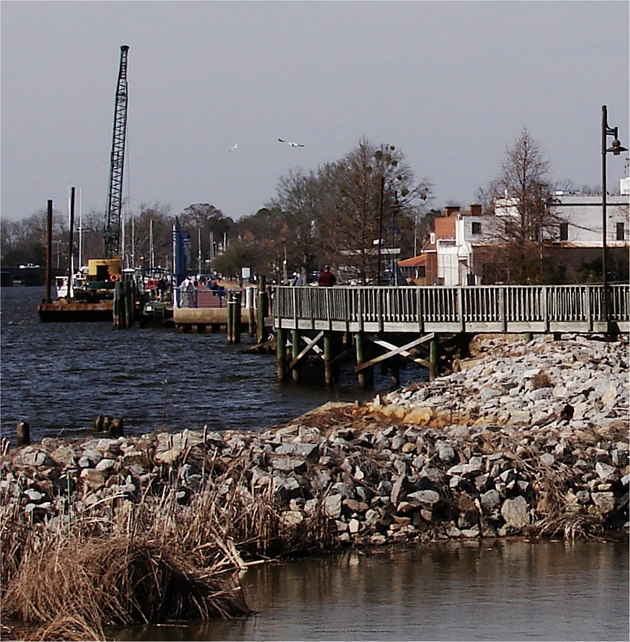Your Basic Needs: Food, Shelter and The TRUTH
Another example of fuzzy science and lazy bureaucratic environmental decision-making
Published: Thursday, February 24th, 2011 @ 9:42 am
By: Beaufort Observer Editorial Team ( More Entries )
By: Beaufort Observer Editorial Team ( More Entries )
Publisher's Note: We appreciate this informative article from our friends at the Beaufort Observer.
Murphy's Law is alive and well...The Washington dock project is dead until at least October
Back around the first of February we published an article growing out of the January Washington City Council meeting in which the council voted to spend a couple of hundred grand more than they had planned on expanding the city-owned docks on the Stewart Parkway waterfront. The council was told that it was urgent that they act because of an impending "moratorium" imposed by the state on pile-driving in the river at this time of year.
As the article states this project has dragged on for years. Now it was urgent. Fortunately, depending on how you looked at it, we learned a few days later that the local Coastal Area Management Act (CAMA) office had granted a two week extension into the moratorium time period to allow the city to complete its pile-driving.
We said at the time that this story had several levels. This article reports on another level--that of how the state issues environmental permits.
So we set out to find out. What we discovered is nothing short of amazing.
But to put this story in proper prospective you have to recall another one two years ago. At that time the contractors building the U. S. 17 By-pass bridge were closing in on completing the bridge but were stopped by this same moratorium that is designed to prevent noise from interfering with the sex lives of certain species of fish that are spawning about that time. The work on the bridge was halted while bureaucrats from multiple agencies debated whether to make an exception to the moratorium against pile-driving so the bridge could be finished. Eventually the bureaucrats were not able to get it done so the work was halted. The contractor, FlatIron, told us at that time that more than 60 people were laid off, and most left to find jobs somewhere else.
So we then went on a quest to find out the scientific basis for this moratorium. We found none. No state agency could cite for us any scientific data or studies that showed that pile-driving had an actual impact on spawning fish. But we did find research from the University of Maryland that said it did not affect spawning unless the pile landed on top of a fish. That study also included a review of the literature on the impact of noise on fish and the conclusions were inconclusive.
But eventually the bridge got finished.
So when we learned that the state had made an exception to the no-pile-driving moratorium this time we wondered what the difference was.
Well, we were told that the difference was the size and scope of the two projects. So we asked to see the data that documented the impact of "size and scope" and we were told there is not such data.
 On February 22, 2010, the steel barge that was tasked with washing down the pilings for the docks was docked: Above. One February 24th, the piling poles remained, but the barge was gone: Below. Images by Stan Deatherage.
On February 22, 2010, the steel barge that was tasked with washing down the pilings for the docks was docked: Above. One February 24th, the piling poles remained, but the barge was gone: Below. Images by Stan Deatherage.

So as we pushed the CAMA people (the ones who issued the permit) we were eventually bumed off onto the Wildlife Resources Commission (WRC). CAMA said WRC made the decision. So we went to the WRC and ask to see the data and the standards they used to make the decision. After two weeks we finally got the answer: "We don't have an actual data and there are actually no standards" they would apply the data to even if they had some data.
You can read our odyssey through the bureaucracy by clicking here. Note, this is a copy of an email trail. You may want to start at the bottom and read up through the messages. The blue was our questions and comments. The read was the initial response, mostly from CAMA. The green is the "final answer" from an unknown writer at WRC.
Commentary
This turned out just as we expected it would. The State of North Carolina has mammoth regulations that bureaucrats use to make decisions that have far reaching consequences on the real lives of people (ex. Construction workers, grant recipients etc.). But when you dig deep enough you find that the regulations often, and most of the time the decisions applying the regulations, are not data or fact-based and as often as not have little or no solid science behind them that is specifically valid or reliable to the actual decision being made. And we have never been able to find a Record of Decision or such that documents the specific data used to make a specific permit comment/decision.
To make this point, we could not have done better than the WRC's own words:
Although we may not have provided the answers you are looking for, the context of our answers are based on best available science and expert knowledge. Please realize that the NC Wildlife Resources Commission has staff in this county that includes decades of biological experience, survey/monitoring expertise, local biological knowledge and survey data to support any of our biological recommendations. Not one person or individual standard can be referenced to help you understand how a conclusion has been reached to help us with wildlife conservation in NC.
It has been our experience when you hear such as this:
Our annual sampling efforts work to ensure our decisions are based on current biological trends. Per a Public Information request this data could be made available to you for viewing at your expense in our Raleigh office. Realize that this request can not be filled immediately since it is located in many offices in hard copy and/or electronic copy in field offices.
What you are actually hearing is: "We don't want you to see this stuff." What is obvious is that what science they do have somewhere is not being used in the field to make everyday decisions, or it would be more readily available.
Here's the way we see it:
This is a case in which the decision is whether to apply the regulation (a moratorium) and stop the pile-driving or whether to make an exception and allow it to continue. That's the same basic decision they made on the U. S. 17 By-pass, but the outcome was the opposite.
Both decisions were based on scientific evidence that certain species of migratory fish spawn in certain areas, mostly creeks running off the Pamlico River. The areas are called Primary Nursery Areas. We have no problem with that.
But then comes the issue of whether a specific human activity will harm the fish using these PNA's to spawn. The presumption is that pile driving will. But there is no specific data or science to support that presumption. More specifically, there is no solid data to show that certain types of human activity will harm the fish while other types of activity will not. As the WRC response notes, they just get their "experts with years of experience" together and decide.
But the same person who offers that as a justifiable decision-making process also says that the "size and scope" of one project was different from another (i.e. the 17 By-pass and the docks). But what we can't understand is what difference it makes during any given period of time whether this is the fifth or fifty-ninth piling that's been driven. Think about it. Both projects are presumably driving only one piling at any given time that any given fish or school of fish is being impacted by the noise. (The permit does not address how many can be driven at any given time). Likewise, common sense would say that the duration of the driving may have more of an impact. So we asked when the By-pass was being built why they did not allow driving intermittently. No answer.
The bureaucrats that compared the two projects also said the By-pass driving made "more noise." But they had no data to support that. Flatiron told us they offered to put buffers in the water around the driving but WRC would not accept that. The University of Maryland study found that the decibles of sound that is high enough to impact a fish decreases rapidly the further away from the source you go. But the permit decisions did not incorporate the variable of how wide the run is at the two different projects.
Then we learned that some fish are more sensitive to obstructions in their run than are other species. In fact, one study found that some fish simply can't be stopped except with an impenetrable barrier the entire width of the run. And then some will be satisfied with alternative areas and adapt.
The point in all that is simple: There is just no data and solid science in the bureaucratic decisions applying the administrative regulations. And that is what we think the General Assembly should change. The state agencies that make these decisions should be required to produce a Record of Decision that shows how the decision was made. That record should cite the standards prescribed by the general regulations (ex. Sound measurements, species counts, water temperature/quality, etc. etc.) and most importantly science-based impact including adverse impact as actually measured in a specific location.
To illustrate, imagine this. Suppose the real, actual impact of continuing with the By-pass bridge would not have actually done any harm to the fish. Or suppose site-specific monitoring would have shown that the impact could have been mitigated. And on and on.
But beyond the science, what the state needs to do is establish standards for permitting decisions that factor in a balance between biological impact and economic impact.
There have been entirely too many environmental scams imposed on the public in recent years because of non-scientific based bureaucrat decisions not supported by sound data. As it is now, the burden of this often arbitrary and capricious system falls on the victims rather than the bureaucrats carrying the burden of showing actual harm. That should be changed.
In fact, we believe all of these regulations should be put on hold until their validity can be verified and a systematic decision-making application can be determined.
Suppose the fish don't care. Or better said, suppose the hanky-panky they are up to is not impacted by a little noise. Just suppose they enjoy it. The noise that is.
And if you've read this far you will be interested in this fact. It's all moot as it relates to the dock project. They ran into technical problems and cannot complete before the extension so it's going to be put on hold until October 1. Wonder if the fish are happy.
Go Back
Murphy's Law is alive and well...The Washington dock project is dead until at least October
Back around the first of February we published an article growing out of the January Washington City Council meeting in which the council voted to spend a couple of hundred grand more than they had planned on expanding the city-owned docks on the Stewart Parkway waterfront. The council was told that it was urgent that they act because of an impending "moratorium" imposed by the state on pile-driving in the river at this time of year.
As the article states this project has dragged on for years. Now it was urgent. Fortunately, depending on how you looked at it, we learned a few days later that the local Coastal Area Management Act (CAMA) office had granted a two week extension into the moratorium time period to allow the city to complete its pile-driving.
We said at the time that this story had several levels. This article reports on another level--that of how the state issues environmental permits.
So we set out to find out. What we discovered is nothing short of amazing.
But to put this story in proper prospective you have to recall another one two years ago. At that time the contractors building the U. S. 17 By-pass bridge were closing in on completing the bridge but were stopped by this same moratorium that is designed to prevent noise from interfering with the sex lives of certain species of fish that are spawning about that time. The work on the bridge was halted while bureaucrats from multiple agencies debated whether to make an exception to the moratorium against pile-driving so the bridge could be finished. Eventually the bureaucrats were not able to get it done so the work was halted. The contractor, FlatIron, told us at that time that more than 60 people were laid off, and most left to find jobs somewhere else.
So we then went on a quest to find out the scientific basis for this moratorium. We found none. No state agency could cite for us any scientific data or studies that showed that pile-driving had an actual impact on spawning fish. But we did find research from the University of Maryland that said it did not affect spawning unless the pile landed on top of a fish. That study also included a review of the literature on the impact of noise on fish and the conclusions were inconclusive.
But eventually the bridge got finished.
So when we learned that the state had made an exception to the no-pile-driving moratorium this time we wondered what the difference was.
Well, we were told that the difference was the size and scope of the two projects. So we asked to see the data that documented the impact of "size and scope" and we were told there is not such data.
 On February 22, 2010, the steel barge that was tasked with washing down the pilings for the docks was docked: Above. One February 24th, the piling poles remained, but the barge was gone: Below. Images by Stan Deatherage.
On February 22, 2010, the steel barge that was tasked with washing down the pilings for the docks was docked: Above. One February 24th, the piling poles remained, but the barge was gone: Below. Images by Stan Deatherage.

So as we pushed the CAMA people (the ones who issued the permit) we were eventually bumed off onto the Wildlife Resources Commission (WRC). CAMA said WRC made the decision. So we went to the WRC and ask to see the data and the standards they used to make the decision. After two weeks we finally got the answer: "We don't have an actual data and there are actually no standards" they would apply the data to even if they had some data.
You can read our odyssey through the bureaucracy by clicking here. Note, this is a copy of an email trail. You may want to start at the bottom and read up through the messages. The blue was our questions and comments. The read was the initial response, mostly from CAMA. The green is the "final answer" from an unknown writer at WRC.
Commentary
This turned out just as we expected it would. The State of North Carolina has mammoth regulations that bureaucrats use to make decisions that have far reaching consequences on the real lives of people (ex. Construction workers, grant recipients etc.). But when you dig deep enough you find that the regulations often, and most of the time the decisions applying the regulations, are not data or fact-based and as often as not have little or no solid science behind them that is specifically valid or reliable to the actual decision being made. And we have never been able to find a Record of Decision or such that documents the specific data used to make a specific permit comment/decision.
To make this point, we could not have done better than the WRC's own words:
Although we may not have provided the answers you are looking for, the context of our answers are based on best available science and expert knowledge. Please realize that the NC Wildlife Resources Commission has staff in this county that includes decades of biological experience, survey/monitoring expertise, local biological knowledge and survey data to support any of our biological recommendations. Not one person or individual standard can be referenced to help you understand how a conclusion has been reached to help us with wildlife conservation in NC.
It has been our experience when you hear such as this:
Our annual sampling efforts work to ensure our decisions are based on current biological trends. Per a Public Information request this data could be made available to you for viewing at your expense in our Raleigh office. Realize that this request can not be filled immediately since it is located in many offices in hard copy and/or electronic copy in field offices.
What you are actually hearing is: "We don't want you to see this stuff." What is obvious is that what science they do have somewhere is not being used in the field to make everyday decisions, or it would be more readily available.
Here's the way we see it:
This is a case in which the decision is whether to apply the regulation (a moratorium) and stop the pile-driving or whether to make an exception and allow it to continue. That's the same basic decision they made on the U. S. 17 By-pass, but the outcome was the opposite.
Both decisions were based on scientific evidence that certain species of migratory fish spawn in certain areas, mostly creeks running off the Pamlico River. The areas are called Primary Nursery Areas. We have no problem with that.
But then comes the issue of whether a specific human activity will harm the fish using these PNA's to spawn. The presumption is that pile driving will. But there is no specific data or science to support that presumption. More specifically, there is no solid data to show that certain types of human activity will harm the fish while other types of activity will not. As the WRC response notes, they just get their "experts with years of experience" together and decide.
But the same person who offers that as a justifiable decision-making process also says that the "size and scope" of one project was different from another (i.e. the 17 By-pass and the docks). But what we can't understand is what difference it makes during any given period of time whether this is the fifth or fifty-ninth piling that's been driven. Think about it. Both projects are presumably driving only one piling at any given time that any given fish or school of fish is being impacted by the noise. (The permit does not address how many can be driven at any given time). Likewise, common sense would say that the duration of the driving may have more of an impact. So we asked when the By-pass was being built why they did not allow driving intermittently. No answer.
The bureaucrats that compared the two projects also said the By-pass driving made "more noise." But they had no data to support that. Flatiron told us they offered to put buffers in the water around the driving but WRC would not accept that. The University of Maryland study found that the decibles of sound that is high enough to impact a fish decreases rapidly the further away from the source you go. But the permit decisions did not incorporate the variable of how wide the run is at the two different projects.
Then we learned that some fish are more sensitive to obstructions in their run than are other species. In fact, one study found that some fish simply can't be stopped except with an impenetrable barrier the entire width of the run. And then some will be satisfied with alternative areas and adapt.
The point in all that is simple: There is just no data and solid science in the bureaucratic decisions applying the administrative regulations. And that is what we think the General Assembly should change. The state agencies that make these decisions should be required to produce a Record of Decision that shows how the decision was made. That record should cite the standards prescribed by the general regulations (ex. Sound measurements, species counts, water temperature/quality, etc. etc.) and most importantly science-based impact including adverse impact as actually measured in a specific location.
To illustrate, imagine this. Suppose the real, actual impact of continuing with the By-pass bridge would not have actually done any harm to the fish. Or suppose site-specific monitoring would have shown that the impact could have been mitigated. And on and on.
But beyond the science, what the state needs to do is establish standards for permitting decisions that factor in a balance between biological impact and economic impact.
There have been entirely too many environmental scams imposed on the public in recent years because of non-scientific based bureaucrat decisions not supported by sound data. As it is now, the burden of this often arbitrary and capricious system falls on the victims rather than the bureaucrats carrying the burden of showing actual harm. That should be changed.
In fact, we believe all of these regulations should be put on hold until their validity can be verified and a systematic decision-making application can be determined.
Suppose the fish don't care. Or better said, suppose the hanky-panky they are up to is not impacted by a little noise. Just suppose they enjoy it. The noise that is.
And if you've read this far you will be interested in this fact. It's all moot as it relates to the dock project. They ran into technical problems and cannot complete before the extension so it's going to be put on hold until October 1. Wonder if the fish are happy.
| WHDA sets date for open-air Marine Market | City of Washington, City Governments | Washington Electric gets a glowing assessment from a tainted study |




















